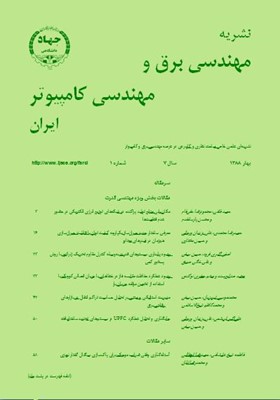رهيافت جديد براي اصلاح روش حفاظت خطاي نابرابر (UEP) در ارسال ويدئو روي شبکههاي بيسيم
محورهای موضوعی : مهندسی برق و کامپیوترحسین قانعی یخدان 1 , مرتضی خادمی 2 , جلیل چيتيزاده 3
1 - دانشگاه یزد
2 - دانشگاه فردوسی مشهد
3 - دانشگاه فردوسی مشهد
کلید واژه: شبکههاي بيسيمويدئوي 4-MPEGبهبود خطاUEP,
چکیده مقاله :
کارآيي ارسال ويدئوي فشردهشده روي شبکههاي بيسيم توسط نويز کانال محدود شده و کيفيت ويدئوي دريافتي بهشدت ضعيف ميگردد. از اين رو چندين ابزار بهبودپذيري خطا به استاندارد فشردهساز ويدئوي 4-MPEG اضافه شده است. علاوه بر اين ابزارها، شيوه حفاظت خطاي نابرابر (UEP) بهمنظور حفاظت بيشتر بخشهاي مختلف در بسته ويدئوي 4-MPEG با نرخهاي کدگذاري متفاوت بر پايه کدهاي RCPC پيشنهاد شده است. با اين حال، تلاشهاي صورتگرفته تاکنون براي شبکههاي بيسيم هنوز براي داشتن کيفيت مطلوب، کافي نميباشد. در اين مقاله، براي مقاومکردن هرچه بيشتر ارسال ويدئوي 4-MPEG روي شبکههاي بيسيم، رهيافت حفاظت خطاي نابرابر اصلاحشده (MUEP) بر پايه محتواي صحنه ويدئو پيشنهاد ميگردد. در روش پيشنهادي، نرخ خروجي کدکننده کانال براي بخش حرکت بسته ويدئوي 4-MPEG بر اساس محتواي حرکت داخل صحنه ويدئو تعيين ميشود. نتايج تجربی نشان میدهد که در روش پیشنهادی علاوه بر افزایش میانگین PSNR تا مقدار dB 5/1 نسبت به روش UEP سنتی، کیفیت ذهنی ویدئوی دریافتی نیز ارتقا مییابد.
The performance of video transmission over wireless channels is limited by the channel noise. Thus many error resilient tools have been incorporated into the MPEG-4 video compression method. In addition to these tools, the unequal error protection (UEP) technique has been proposed to protect the different parts in a MPEG4 video packet with different channel coding rates based on the rate compatible punctured convolutional (RCPC) codes. However, it is still not powerful enough to achieve a high visual quality over the wireless networks. To provide more robust MPEG-4 video transmission over wireless channels, this paper proposes a modified unequal error protection (MUEP) approach based on the content of the video scene. In proposed technique, channel coding rates for motion section of the video packet are determined based on the motion of the video scene. Experimental results show that the proposed technique enhances both subjective visual quality and PSNR about 1.5 dB, comparing to the traditional UEP method.
[1]R. Koenen, Overview of the MPEG-4 Standard, ISO/IEC JTC1/SC29/WG11 M4030, 2001.
[2]B. Yan and K. M. Ng, "A survey on the techniques for the transport of MPEG-4 video over wireless networks," IEEE Trans. on Consumer Electronies, vol. 48, no. 4, pp. 863-873, Nov. 2002.
[3]L. D. Soares and F. Pereira, "MPEG-4: a flexible coding standard for the emerging mobile multimedia applications," in Proc. 9th IEEE Int. Symp. on Personal, Indoor and Mobile Radio Communications, vol. 3, pp. 1335-1339, 8-11 Sep. 998.
[4]J. Zhu, A. Matrawy, and I. Lambadaris, "Models and tools for simulation of video transmission on wireless networks," in Proc. CCECE’04 – CCGEL’04, Niagara Falls, May 2004.
[5]Requirements Group, MPEG4 Applications, ISO/IEC JTC1/SC29/WG11 MPEG 99/N272, Mar. 1999.
[6]T. Sikora, "Trends and perspectivesin image and video coding," in Proceeding of the IEEE, vol. 93, no. 1, pp. 6-17, Jan. 2005.
[7]B. Yan and K. W. Ng, "Mode-base error-resilient techniqques for the robust communication of MPEG- 4 video," IEEE. Trans. on Circuits and Systems for Video Technology, vol. 14, no. 6, pp. 874-879, Jun. 2004.
[8]B. Du, "Multimedia communication in wireless environment," in Proc. 12th Int. Conf. Mult.-.Media Modelling , pp. 460-464, 4-6 Jan. 2006.
[9]W. R. Heinzelman, M. Budagavi, and R. Talluri, "Unequal error protection of MPEG-4 compressed video," in Proc. IEEE In. Conf. onImage Processing, ICIP ‘99, vol. 2, pp. 530-534, Oct. 1999.
[10]C. Adsumilli and Y. H. Hu, "A dynamically adaptive constrained unequal error protection scheme fo r video transmission over wireless channels," in Proc. IEEE Workshop on Multimedia Signal Processing, pp. 41-44, Dec. 2002.
[11]A. E. Mohr, E. A. Riskin, and R. E. Ladner, "Unequal loss protection: graceful degradation over packet erasure channels through forward error correction," IEEE J. on Selected Areas in Comm., vol. 18, no. 7, pp. 819-828, Jun. 2000.
[12]M. Grangetto, E. Magli, M. Marzo, and G. Olmo, "Guaranteeing quality of service for image transmission by means of hybrid loss protection," in Proc. Int. Conf. on Multimedia and Expo., vol. 2, pp. 469-472, 2002.
[13]S. L. Regunathan and K. Rose, "Robust video compression for time-varying wireless channels," in Proc. Visual Comm. and Image Processing, San Jose, CA, US, Jan. 1999.
[14]C. Lie, "On the unequal error protection for progressive image transmission," IEEE Trans. on Image Processing , vol. 16, no. 9, pp. 2384-2388, Sep. 2007.
[15]G. Cheung and A. Zakhor, "Bit allocation for joint source/channel coding of scalable video," IEEE Trans. on Image Proc., vol. 9, no. 3, pp. 340-356, Mar. 2000.
[16]M. G. Martini and M. Chiani, "Proportional unequal error protection for MPEG-4 video transmission," in Proc. IEEE Int. Conf. on Communications, ICC’01., vol. 4, pp. 1033-1037, Jun. 2001.
[17]B. Yan and K. W. Ng, "An improved unequal error protection technique for the wireless transmission of MPEG-4 video," in Proc. ICICS-PCM, vol. 1, pp. 513-517, 15-18 Dec. 2003.
[18]T. C. Yin, Y. C. Huang, M. H. Lin, and W. C. Chen, "Error-resilient MPEG-4 video communication over error- prone wireless networks," in Digest of Technical Papers Int. Conf. on Consumer Electronics, ICCE’05,pp. 313-314, Jan. 2005.
[19]J. Hagenauer, "Rate-compatible punctured convolutional codes (RCPC codes) and their applications," IEEE Trans. on Comm., vol. 36, no. 4, pp. 389-399, Apr. 1988.
[20]C. Li, J. Lu, and K. B. Letaief, "Adaptive error resilient video transmission over wide-band CDMA networks," in Proc. IEEE VTS 53rd Vehicular Technology Conf., vol. 3, pp. 2086-2090, May 2001.
[21]S. A. J. Winder, ISO/IEC 14496 (MPEG-4) Video Reference Software, version: Microsoft-FPDAM1-1.0-000403, last update: Feb. 5, 2007.


